“National Seminar on Cataloguing, editing and Publication of Ancient Indian Manuscripts on Science and Technology” held on March 25th 28th 2019 at Bangalore [5]

K. V. Ramakrishna Rao, M. S. Vijyaraghavan, S. R. Ramaurthy, Agnihothri…………..
28-03-2019 – 11.15 to 1.00 pm: The sixth and the last session was chaired by Dr. M. S. Vijayaraghavan, Ex-JS of PMO, Bangalore, and the following papers were presented:
| Sl. No | Name of the Presenter | Topic |
| 1 | Mr. K. V. Ramakrishna Rao Independent Researcher, Chennai |
Shipping technology of the Tamils – based on the Manuscripts available |
| 2 | S. R. Rama Murthy | Vedic literature |
| 3 | Agnihotri | Kannada Manuscript |
K. V. Ramakrishna Rao tried to link the Rajendra Chola shipping technology with that of the manuscripts available – Kappal Sathiram கப்பற் சாத்திரம்[1] [Science and Technology of Ships and Shipping[2]], Navay Sathiram – நாவாய் சாத்திரம்[3] [Book for manufacture of boat, ship etc[4]], Kappal Kovai – கப்பற் கோவை[5] [A Compendium on Ships], Besides the above specific works, there had been other PLBs also, as found in the books:
- சரஸ்வதிஅந்தாதி [Saraswati Anthathi]
- சோதிடகிரகசிந்தாமணி [Jyothida graha Cintamani]
- கணக்கதிகாரம் [A Book of Calculattions (for Shipbuilding)]
- நீகம சிகாமணி [Nigama sigamani]
கப்பல் நெருப்பு பற்றிய அபாய சிந்து [Kappal neruppu patriya abaya chindu]
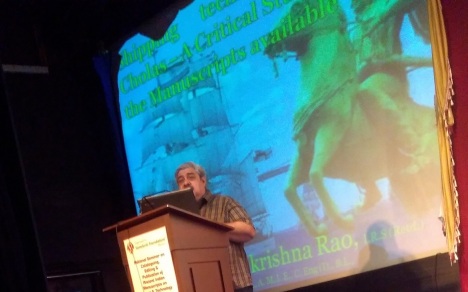
K. V. Ramakrishna Rao presenting his paper on “Shipping technology of the Tamils – based on the Manuscripts available”
Nagapatnam, Caddalore, Madras, Pulicat, Arumuganeri, Machilipatnam, Narsapur, Srikakulam, Kalingappatnam etc., had been the important ports and shipyards, where shipbuilding and repairing activities were going on till 18th century. He concluded as follows:
- With the internal evidences, the data, details and information are correlated, corroborated and corresponded with that of the imperial Cholas, who had exercised their maritime influence throughout the Coromandel Coast and also coasts that of South East Asian countries.
- These PLB amply prove the existence of such tradition of shipbuilding involving selection of very good wood, quality of the carpenter, the sincere work of wood workers, shipbuilding, preparing for the first sail, actual first sail on the most auspicious time, day etc., praying for the safe return of the ship – captain, sailors and others with goods and profits, and celebrating such return.
- Te manuscript evidences prove the existence of coastal navigation, the co-operation among the sailors, shipbuilders, repairers etc., on the Coromandel coast.
- Therefore, in that context, the manuscripts serve as evidence to prove the continuance of shipbuilding activities and hence the maritime expedition of Rajendra Chola during the 12th
- As Rajendra Chola’s sojourn has been proved based on the inscriptions, copper plates and cross checked with that of the countries mentioned, the manuscript approach is also added to establish the historical fact. Hence, the manuscripts are also used for such studies.
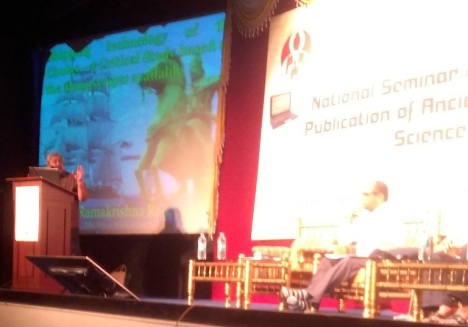
K. V. Ramakrishna Rao presenting his paper on “Shipping technology of the Tamils – based on the Manuscripts available”

K. V. Ramakrishna Rao presenting his paper on “Shipping technology of the Tamils – based on the Manuscripts available” and M. S. Vijayaraghavan interacting

K. V. Ramakrishna Rao facilitated by Prof Lakhsmi Thathachariar
S. R. Rama Murthy tried to correct some verses of Valmiki Rammayana, as they do not give proper meaning. However, a group of scholars analysed the verses from the hundreds of manuscripts and brought out one critical edition of Valmiki Ramayana. Therefore, there is no necessity for him to do such exercise. When pointed out, he says that the critical edition itself is wrong and he would not accept. He was also debunking “Saraswati river” and the research thereon, carried on by the Haryana government. In fact, he tried to interpret that the Brahmaputra was Saraswati, flow of direction changed.
The last paper presenter “Agnihothri………….” was talking in general about some Kannada manuscripts. In fact, he was speaking in Kannada and claimed that the Kannada is the oldest language other than Sanskrit and its date id c.520 CE. However, I pointed out that the Battiporlu inscription contains the earliest Telugu script dated to c.120 BCE.
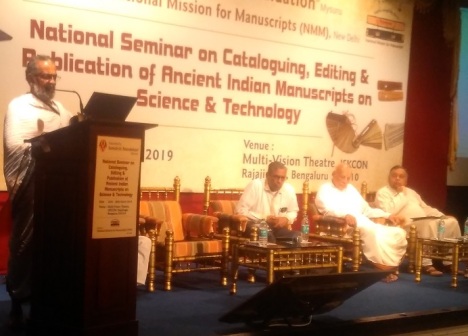
Panel discussion: From 2.30 to 4.00 pm: There was a panel discussion with the chair person – Prof.M.A.Lakshmithathachar, President, SF, Mysore and Dr. M. S. Vijayaraghavan, Dr. P. Ramanujan Dr. M. D.Sreenivas Dr. Sai Susarla and Sanjay Singhla discussed about the problems and issued involved in the Cataloguing, editing and Publication of Ancient Indian Manuscripts on Science and Technology. The points are as follows:

- They mainly discussed about the divide existing between the traditional Sanskrit pundits and IT experts dealing with Sanskrit manuscripts, conversion of manuscripts data into information.
- Divide also exists between the traditional Sanskrit pundits, Sanskrit college products and the foreign categories.
- The traditional Sanskrit pundits feel that they are not respected or treated properly.
- The traditional Sanskrit pundits do not want to IT field and most of the IT experts do not want to engage with Sanskrit business [digitization of manuscripts, reading and interpretation of them etc].
- The existing “Vedic-IT combo” experts[6] fight with each other with ego and other issues. Perhaps, they do not like each other, as many times, they enter into area of others in research, electronic conversion of data with their expertise.
- The same or same type of work is carried on by many individuals, groups and institutions, yet, there is no co-ordination, co-operation and understanding among themselves. That in Bangalore itself, many engage in such work has already been pointed out.
- The Indian categories of all sorts, are still not able to counter the non-Indian or westerners scholarship. The latter group always look down the for group. Ironically, 70% of the latter group cannot speak Sanskrit, read and understand Sanskrit.
- Sanskrit should be addressed to the common people for solving their day to day problems, then, only, they can believe.
- The instrument that is to e discovered by the “Vedic-IT combo” experts should be utility oriented for the common people, just like, mobile phone, now used by all people, irrespective of the fact that the users talk different languages, have enough knowledge or not, rich or poor etc.
- “Vedic-IT combo” experts or anybody dealing with these subjects should learn from the original and then, only, they could understand the nuances of the language, literature, epistemology etc., so that they could proceed with decoding, deciphering and interpreting the data and information digitized.
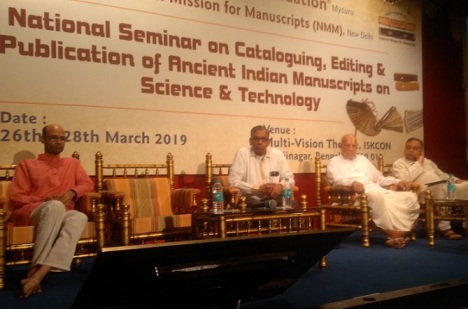
My observations on the proceedings of the seminar: I had a strong feeling that we were neglected or ignored from the beginning, as we had not received any reply-e-mail, in spite of dozens of e-mail sent with telephonic enquiries made almost everyday from the first week of March. In spite of on-line registration, sending full paper in advance, with a lot of data and information, the organizers never responded to send any information – acceptance or rejection of the papers as per the dates fixed etc., Even after registration and the date lines elapse and our informing travel program, program, list of papers, invitation etc., were not sent. Even after reaching ISKCON complex, also, we had to enquire and come inside the auditorium for inaugural session on 26th March. Yes, I have to record this experience, as this could not happen, when the whole group has been so computer savvy with a lot of “Vedic-IT combo” experts. On 27th afternoon, the receptionist gave the program list informing that the organizers asked to give it to me.
As for as Mr M. J. Nagarajan is concerned, I told Dr Alwar that he was not so comfortable with English, therefore, I could translate, if he deliver in Tamil, but, he asked Nagarajan himself to present in English. Later, we found that several scholars presented papers in Sanskrit, Hindi and in Kannada also! Therefore, there is nothing odd or unusual that he could have presented in Tamil. Interestingly, most of the audiences were talking among themselves and with each other in Tamil proving that they knew Tamil very well. Incidentally, most of the Palm leave manuscripts have been in Tamil only. Therefore, in spite of the divides dealt with by the experts above, the dive that visibly exhibited – the Sanskrit-Tamil divide, Tamil-non-Tamil divide, question allowed-not allowed divide etc., should have been avoided for a real dialogue, so that first Indians could understand and get benefited from their manuscripts.
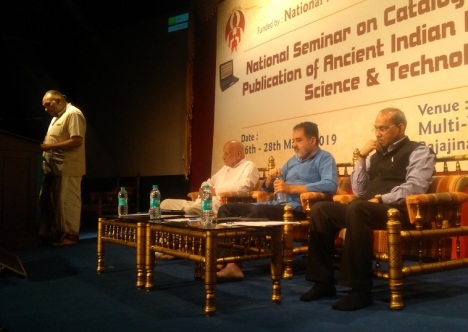
Valedictory function: The speech of T. V. Mohandass Pai at the Valedictory function had been the touching point of the theme of the seminar, though, he did not talk about the manuscripts, but, some important historical issues. He pointed out the clash of civilization taking place.
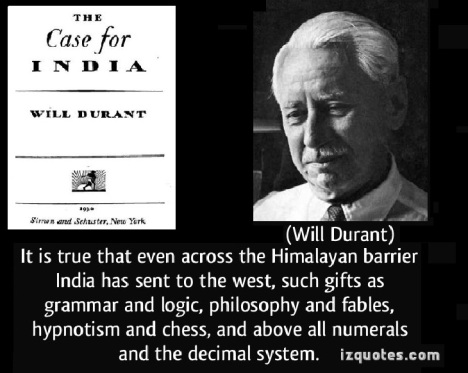
Quoting from Will Durant, “The Case for India,” Robert Clive who traded money for guns and favor, East India Company, forcing Indians to sell cheap, buy exorbitantly. Extracted hundreds of millions of dollars, Indians were taxed at two times the people in England and three times in Scotland. All the costs of British conquests, developments and administration in India was charged to Indians, including the first World war, second world war, all the French battles that they had, everything was charged to Indians. The British incurred a debt for Indians of 35 million in 1792. By 1860, it would become 500 million dollars by 1929 when Will Durant left India it was 3.5 billion dollars. After that was second world war and so on. So, this figure had doubled or tripled by the time the British left India. …..the total drain from 1765 to 1938, compounded up to 2016, comes to £9.2 trillion; since $4.86 exchanged for £1 those days, this sum equals about $45 trillion. Moreover, the cost of human suffering, through famines and the loss of Indian lives in wars waged by the British to capture Indian territories, from Punjab to Assam, has not been computed. India has 30,0000 tonnes of gold. In 2030 India would be dominant. He asked crucial questions – how the nomadic people coming from the European steppes could have composed Vedas, thus questioning the AIT. He pointed out the bias in questioning the Indian legends, but accepting believing myths like resurrection etc. K. Srinivasa Rao, Secretary, Sahitya Academy pointed out the importance of manuscripts preservation, digitization and availability of the to all. Thathachariyar in one line accepted what Pai had spoken.
© K. V. Ramakrishna Rao
30-03-2019

With our friend Sri Gagan and colleague Sri M. J. Nagarajan
[1] T. Chandrasekharan (Gen.Ed.), Kappal Sattiram, Madras Government Oriental Series, Government Oriental Manuscripts Library, Madras, 1950. Critically edited with introduction by T. P. Palaniyappa Pillai.
[2] D. No.1996, and D.No.1997 = TD. 75 (paper), TD.135 (Mackanzie collection), a paper manuscript containing 79 pages having 18 lines in a page.
[3] D. 2015 [T. 5084, 5085, 5086, 7250] of Government Oriental Manuscript Libarary, Madras.
[4] S. Soundarapandian, Navai Sattiram, Madras Government Oriental Series, Government Oriental Manuscripts Library, Madras, 1995.
[5] S. Srivivasa Iyer (Ed.), Kapparkovai, Mahamahopadhyaya V. Swaminatha Iyer Library, Madras, 1958, pp.xxi-xxii.
[6] I am using this expression to denote to modern IT experts, who also deal with Sanskrit, Sanskrit manuscripts, manuscripts containing data and information and conversion of them to other languages for further utility or research etc.
Filed under: A case for India, Kalingappatnam, M. S. Vijayaraghavan, P. Ramanujan, ship, shipbuilding, shipbuilding technology, shipping, Shipping technology of the Tamils, Vedic-IT combo, Will Durant | Tagged: A case for India, Arumuganeri, Caddalore, chola ship, Kalingappatnam, M. S. Vijayaraghavan, Machilipatnam, Madras, Nagapatnam, Narsapur, P. Ramanujan, Pulicat, shipbuilding, shipbuilding technology, shipping, Shipping technology of the Tamils, Srikakulam, Vedic-IT combo, Will Durant | Leave a comment »

